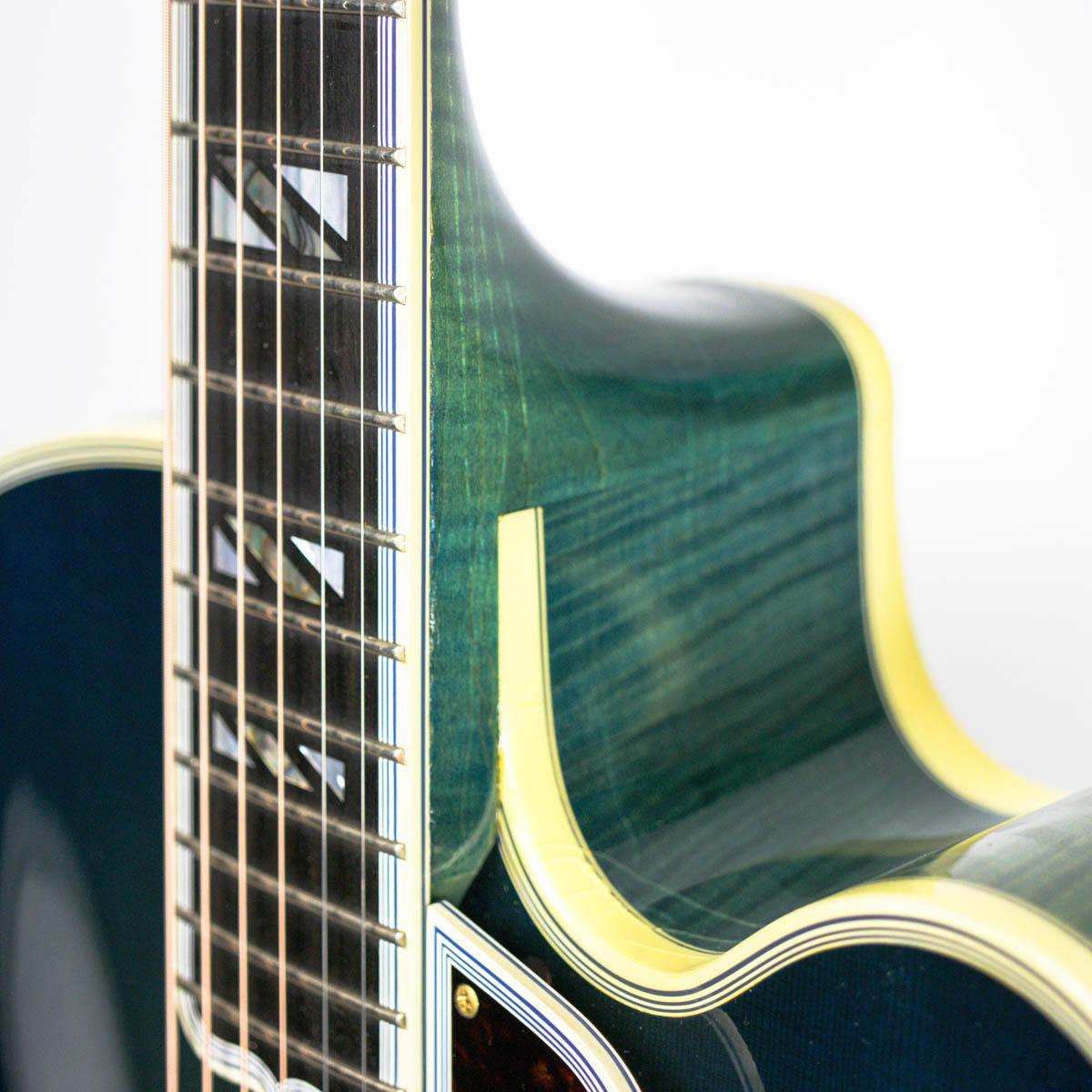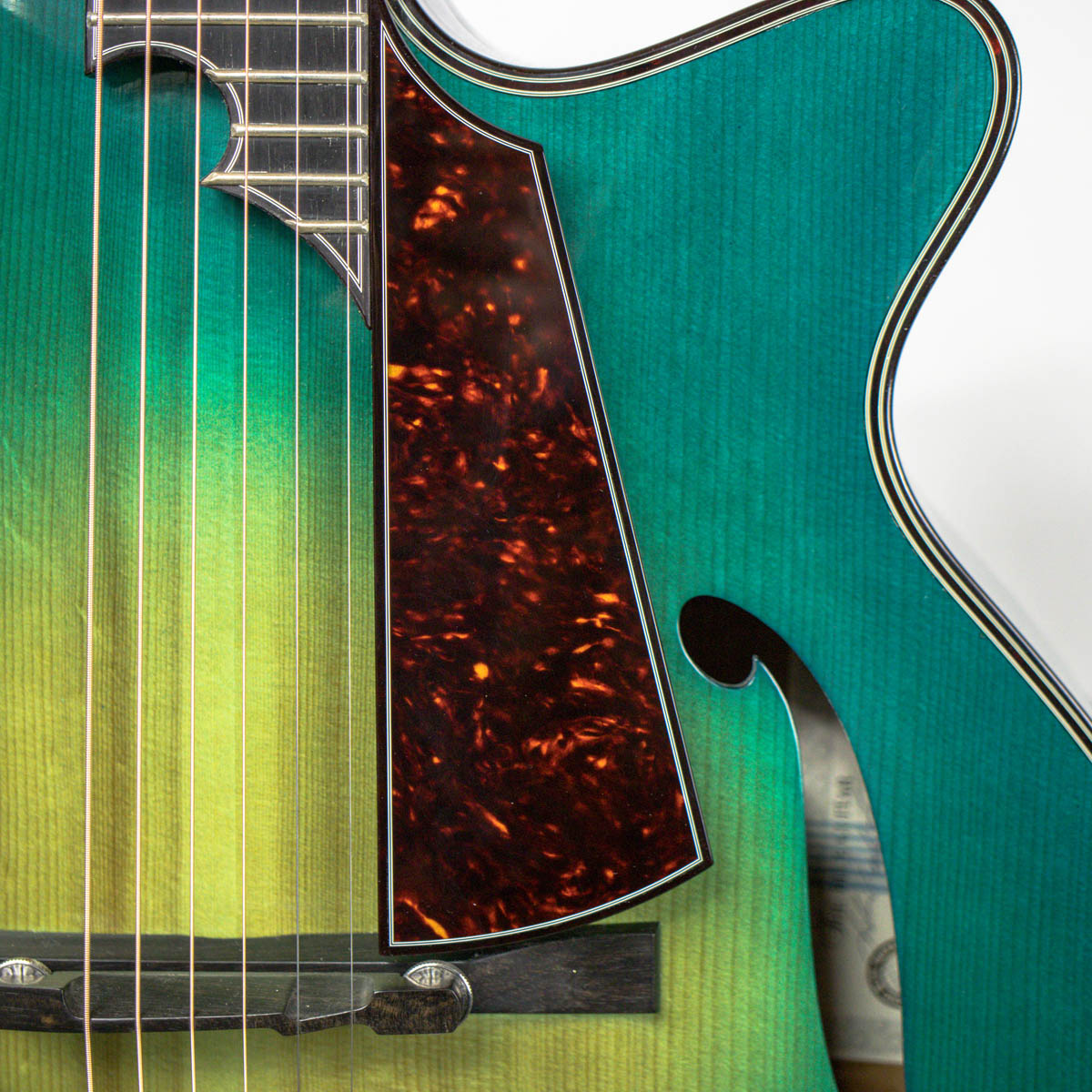
Why the Archtop?
Archtop guitars are very different in construction and tone compared to flattop guitars. These differences offer both challenges and opportunities in their design.
The most fundamental and obvious difference is the top of the guitar. All archtop guitars require crafting an arched top, attaching the strings to the strap-pin side of the guitar with a tailpiece, and connecting those strings to the top via a floating bridge. This design causes the strings to press downward on the arched surface placing the top in compression – employing the same principle that makes bridges and other archways in architecture, strong. Conversely, the strings of a flattop guitar are attached to the top itself – constantly pulling on the top, keeping the top in tension.
When wood fibers are placed in compression, the top becomes stronger. When in tension, the fibers weaken over time. From an engineering perspective, this means that a well-built archtop guitar should be more stable over time and require less maintenance. Flattop guitars inevitably require adjustments as the top warps under tension over the years. Common problems are bellying, splitting, bracing issues, and the bridge pulling up.
The archtop guitar, therefore, is a more reliable way to build a guitar that will last and improve over time. However, this is at a cost. Getting the energy of a vibrating string into the top is how the guitar works to move air and produce sound. Directly attaching the strings to the top, just behind the saddle is a very efficient way to transmit that energy from the strings to the top. The full force of the string pulls on the top (and headstock, of course). In an archtop, much of the force of the string pull is carried by the guitar body through the tailpiece and its connection to the strap-pin side of the guitar. Only a geometric portion of that force pushes down on the top. This weaker connection of string to top means that the vibrations of the string get transmitted to the top at lower volume.
Getting volume from an archtop guitar initially involved building them bigger to move more air. However, with the advent of magnetic guitar pickups, the problem of volume could be solved. While this helped the archtop guitar gain prominence, it also served, temporarily at least, to stall engineering advances in the acoustic performance of the archtop guitar.


The archtop guitar, therefore, is a more reliable way to build a guitar that will last and improve over time. However, this is at a cost. Getting the energy of a vibrating string into the top is how the guitar works to move air and produce sound. Directly attaching the strings to the top, just behind the saddle is a very efficient way to transmit that energy from the strings to the top. The full force of the string pulls on the top (and headstock, of course). In an archtop, much of the force of the string pull is carried by the guitar body through the tailpiece and its connection to the strap-pin side of the guitar. Only a geometric portion of that force pushes down on the top. This weaker connection of string to top means that the vibrations of the string get transmitted to the top at lower volume.
Getting volume from an archtop guitar initially involved building them bigger to move more air. However, with the advent of magnetic guitar pickups, the problem of volume could be solved. While this helped the archtop guitar gain prominence, it also served to, temporarily at least, stall engineering advances in the acoustic performance of the archtop guitar.
In addition, because of the way an archtop gets the energy from the vibrating string into the guitar’s top (or soundboard), the tone of an archtop is very different than a flattop. Getting a full range of sound from an archtop can be more difficult than from a flattop simply because there is less sound energy to work with. But the characteristic tone of an archtop, which often lacks the brightness or deep bass possible from a well-built flattop, makes it a perfect instrument for ensemble playing. This is why it is more common to see a singer-songwriter or fingerstylist play a flattop, while archtops are more common in band settings, often requiring magnetic pickups to achieve the volume needed.
Because of the structural advantages of the archtop, and the potential for them to be ‘forever’ instruments, the science and craft behind their design and manufacture has continued to evolve. The goal is to produce an acoustic archtop that is louder and with a broader, fuller sound. In 1995, Scott Chinery challenged 21 of the top archtop builders in the US and abroad to innovate and advance the technology of the acoustic archtop. This collection represents a renaissance in the construction of the archtop, where new ideas in design and construction were explored. It is fascinating to play these guitars and to hear the differences in tone, volume and playability that these innovations produced.
Because of the inherent stability of the archtop design, having a top in compression rather than tension, the Archtop is a ‘forever’ instrument. As such, builders have also focused on the beauty and appointments of their guitars. From extensive edge binding and inlay to unique carving and metalwork, archtops have evolved to be works of art as well as musical instruments. The Chinery collection is an excellent example of this with several builders going above and beyond to create unique artistic statements in their functional designs.
The Archtop Foundation believes that a new renaissance of the acoustic archtop is due. Advances in materials, building technique and acoustical science have enabled luthiers to rethink the possibilities of the acoustic archtop. Acoustic archtops can be made smaller, louder and with fuller sound today. The Archtop Foundation will be commissioning additional ‘Blue Guitars’ to provide new innovators in archtop design an opportunity to reset standards and expectations for the acoustic archtop. Our mission is to use the original Blue Guitar collection to raise awareness of this important musical technology and art form, while supporting its continued evolution. We believe that the acoustic archtop is the pinnacle of guitar design, a truly ‘forever’ guitar, whose potential has not yet been reached. We hope you enjoy taking this journey with us.
